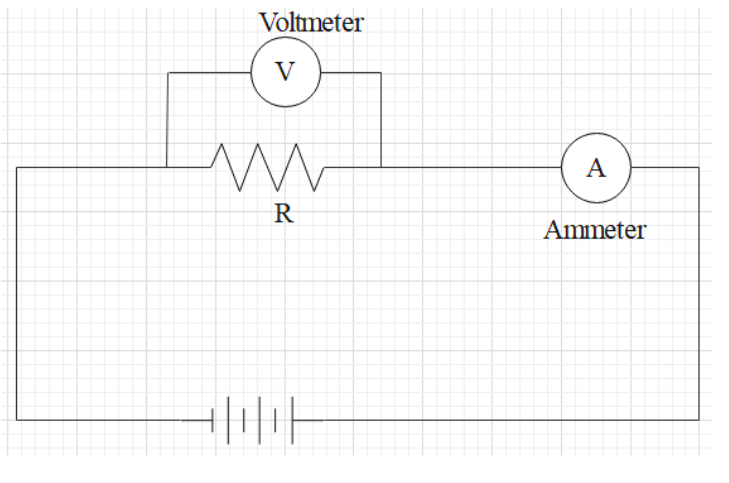
How do we connect the ammeter and voltmeter in an electrical circuit? Draw a circuit diagram in order to justify your answer. What will be happening if the positions of these instruments are interchanged? Specify the reasons.
Answer
557.1k+ views
Hint: A voltmeter has been defined as a device used for measuring the electrical potential difference between the two points in an electric circuit. An ammeter has been a measuring instrument which will be useful for measuring the electric current in a circuit. This will help you in answering this question.
Complete step-by-step solution
A voltmeter has been defined as a device used for measuring the electrical potential difference between the two points in an electric circuit. An ammeter has been a measuring instrument which will be useful for measuring the electric current in a circuit. An ammeter will be always connected in series as it has a low resistance and the Voltmeter will be always connected in parallel because it will be having a high resistance. On interchanging their position, An ammeter is usually connected in parallel. Since it will be having a very low resistance, most of the current will be flowing through it and will be resulting in a short circuit and can also damage the circuit. Now, if the Voltmeter has been connected in series as it will be having a high resistance no current will flow through it, and the voltage indicated will be zero.

Note: Shunt resistance has been defined as a small resistance which has been kept in parallel with a galvanometer in order to create an ammeter. The larger the amount of current to be measured, the smaller the resistance to be connected. Most of the current flowing through the meter has to be shunted through the resistance in order to protect the galvanometer. Galvanometer has been defined as an analog measuring instrument which has been denoted as G which is measuring the current flow by the use of a needle deflection resulted by a magnetic field force experienced upon a current-carrying wire.
Complete step-by-step solution
A voltmeter has been defined as a device used for measuring the electrical potential difference between the two points in an electric circuit. An ammeter has been a measuring instrument which will be useful for measuring the electric current in a circuit. An ammeter will be always connected in series as it has a low resistance and the Voltmeter will be always connected in parallel because it will be having a high resistance. On interchanging their position, An ammeter is usually connected in parallel. Since it will be having a very low resistance, most of the current will be flowing through it and will be resulting in a short circuit and can also damage the circuit. Now, if the Voltmeter has been connected in series as it will be having a high resistance no current will flow through it, and the voltage indicated will be zero.

Note: Shunt resistance has been defined as a small resistance which has been kept in parallel with a galvanometer in order to create an ammeter. The larger the amount of current to be measured, the smaller the resistance to be connected. Most of the current flowing through the meter has to be shunted through the resistance in order to protect the galvanometer. Galvanometer has been defined as an analog measuring instrument which has been denoted as G which is measuring the current flow by the use of a needle deflection resulted by a magnetic field force experienced upon a current-carrying wire.
Recently Updated Pages
A man running at a speed 5 ms is viewed in the side class 12 physics CBSE

The number of solutions in x in 02pi for which sqrt class 12 maths CBSE

State and explain Hardy Weinbergs Principle class 12 biology CBSE

Write any two methods of preparation of phenol Give class 12 chemistry CBSE

Which of the following statements is wrong a Amnion class 12 biology CBSE

Differentiate between action potential and resting class 12 biology CBSE

Trending doubts
What are the major means of transport Explain each class 12 social science CBSE

Which are the Top 10 Largest Countries of the World?

Draw a labelled sketch of the human eye class 12 physics CBSE

How much time does it take to bleed after eating p class 12 biology CBSE

Explain sex determination in humans with line diag class 12 biology CBSE

Explain sex determination in humans with the help of class 12 biology CBSE




